Long noncoding RNA MALAT1 regulates autophagy associated chemoresistance via miR-23b-3p sequestration in gastric cancer
- PMID: 29162158
- PMCID: PMC5699172
- DOI: 10.1186/s12943-017-0743-3
Long noncoding RNA MALAT1 regulates autophagy associated chemoresistance via miR-23b-3p sequestration in gastric cancer
Abstract
Background: Chemoresistance has long been recognized as a major obstacle in cancer therapy. Clarifying the underlying mechanism of chemoresistance would result in novel strategies to improve patient's response to chemotherapeutics.
Methods: lncRNA expression levels in gastric cancer (GC) cells was detected by quantitative real-time PCR (qPCR). MALAT1 shRNAs and overexpression vector were transfected into GC cells to down-regulate or up-regulate MALAT1 expression. In vitro and in vivo assays were performed to investigate the functional role of MALAT1 in autophagy associated chemoresistance.
Results: We showed that chemoresistant GC cells had higher levels of MALAT1 and increased autophagy compared with parental cells. Silencing of MALAT1 inhibited chemo-induced autophagy, whereas MALAT1 promoted autophagy in gastric cancer cells. Knockdown of MALAT1 sensitized GC cells to chemotherapeutics. MALAT1 acts as a competing endogenous RNA for miR-23b-3p and attenuates the inhibitory effect of miR-23b-3p on ATG12, leading to chemo-induced autophagy and chemoresistance in GC cells.
Conclusions: Taken together, our study revealed a novel mechanism of lncRNA-regulated autophagy-related chemoresistance in GC, casting new lights on the understanding of chemoresistance.
Keywords: Autophagy; Chemoresistance; Gastric cancer; MALAT1; lncRNA.
Conflict of interest statement
Competing interests
The authors declare that they have no competing interests.
Publisher’s Note
Springer Nature remains neutral with regard to jurisdictional claims in published maps and institutional affiliations.
Figures
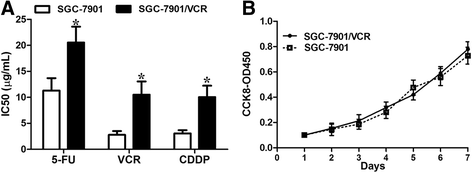
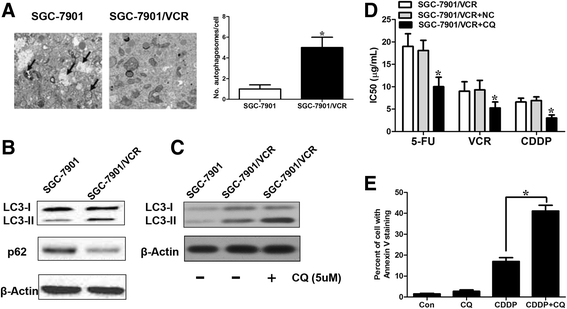
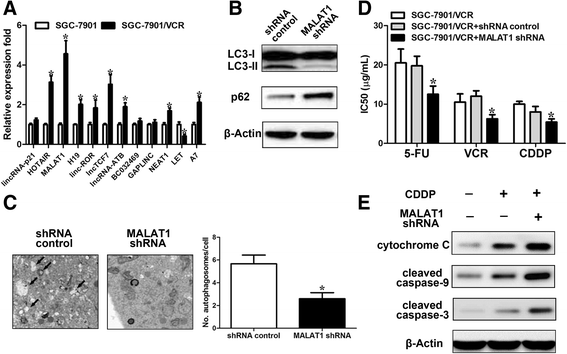
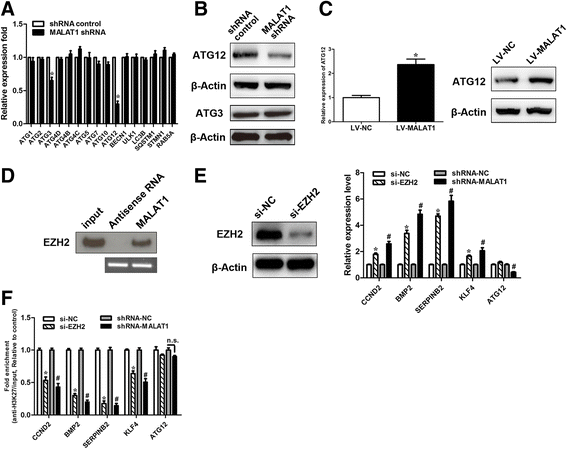
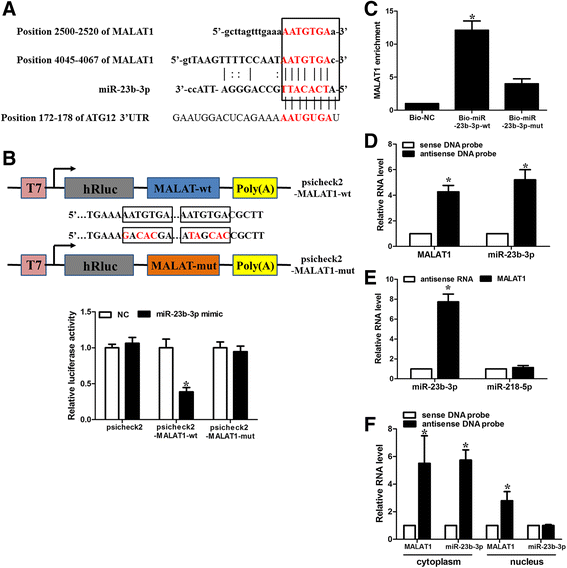
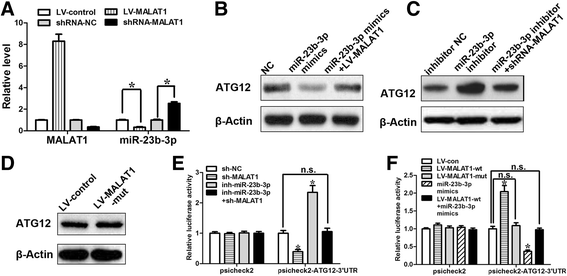
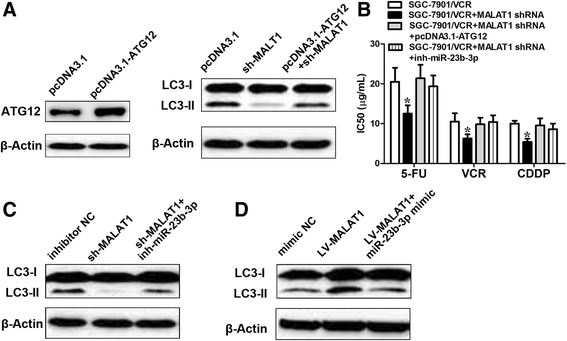

Similar articles
-
Propofol facilitates cisplatin sensitivity via lncRNA MALAT1/miR-30e/ATG5 axis through suppressing autophagy in gastric cancer.Life Sci. 2020 Mar 1;244:117280. doi: 10.1016/j.lfs.2020.117280. Epub 2020 Jan 8. Life Sci. 2020. PMID: 31926239
-
miR-23b-3p regulates the chemoresistance of gastric cancer cells by targeting ATG12 and HMGB2.Cell Death Dis. 2015 May 21;6(5):e1766. doi: 10.1038/cddis.2015.123. Cell Death Dis. 2015. PMID: 25996293 Free PMC article.
-
Long non-coding RNA metastasis-associated lung adenocarcinoma transcript 1 regulates the expression of Gli2 by miR-202 to strengthen gastric cancer progression.Biomed Pharmacother. 2017 Jan;85:264-271. doi: 10.1016/j.biopha.2016.11.014. Epub 2016 Nov 22. Biomed Pharmacother. 2017. PMID: 27887846
-
Molecular Mechanism of the Canonical Oncogenic lncRNA MALAT1 in Gastric Cancer.Curr Med Chem. 2021;28(42):8800-8809. doi: 10.2174/0929867328666210521213352. Curr Med Chem. 2021. PMID: 34036905 Review.
-
MALAT1-miRNAs network regulate thymidylate synthase and affect 5FU-based chemotherapy.Mol Med. 2022 Aug 3;28(1):89. doi: 10.1186/s10020-022-00516-2. Mol Med. 2022. PMID: 35922756 Free PMC article. Review.
Cited by
-
The emerging role of super enhancer-derived noncoding RNAs in human cancer.Theranostics. 2020 Sep 2;10(24):11049-11062. doi: 10.7150/thno.49168. eCollection 2020. Theranostics. 2020. PMID: 33042269 Free PMC article. Review.
-
Long-Chain Non-Coding RNA Metastasis-Related Lung Adenocarcinoma Transcript 1 (MALAT1) Promotes the Proliferation and Migration of Human Pulmonary Artery Smooth Muscle Cells (hPASMCs) by Regulating the MicroRNA-503 (miR-503)/Toll-Like Receptor 4 (TLR4) Signal Axis.Med Sci Monit. 2020 Jul 13;26:e923123. doi: 10.12659/MSM.923123. Med Sci Monit. 2020. PMID: 32712618 Free PMC article.
-
A novel lncRNA TCLlnc1 promotes peripheral T cell lymphoma progression through acting as a modular scaffold of HNRNPD and YBX1 complexes.Cell Death Dis. 2021 Mar 25;12(4):321. doi: 10.1038/s41419-021-03594-y. Cell Death Dis. 2021. PMID: 33767152 Free PMC article.
-
Long non-coding RNAs in gastric cancer: New emerging biological functions and therapeutic implications.Theranostics. 2020 Jul 11;10(19):8880-8902. doi: 10.7150/thno.47548. eCollection 2020. Theranostics. 2020. PMID: 32754285 Free PMC article. Review.
-
Secondary Structural Model of Human MALAT1 Reveals Multiple Structure-Function Relationships.Int J Mol Sci. 2019 Nov 9;20(22):5610. doi: 10.3390/ijms20225610. Int J Mol Sci. 2019. PMID: 31717552 Free PMC article.
References
MeSH terms
Substances
Grants and funding
LinkOut - more resources
Full Text Sources
Other Literature Sources
Medical
Miscellaneous

